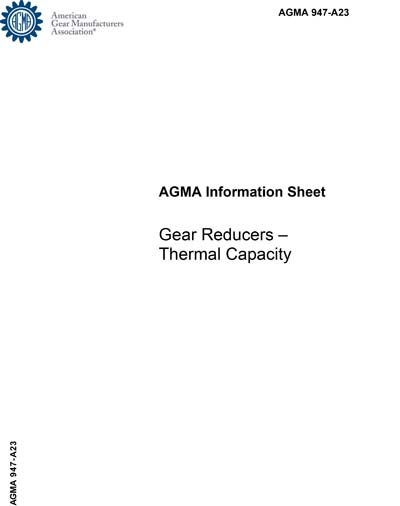Most recent
AGMA 947-A23
Gear Reducers - Thermal Capacity
ABSTRACT This information sheet utilizes an analytical heat balance model to provide a means of calculating the thermal transmittable power of a single- or multiple-stage gear drive lubricated with mineral oil. The calculation is based on standard conditions of 25°C maximum ambient temperature and 95°C maximum oil sump temperature in a large indoor space but provides modifiers for other conditions. FOREWORD This thermal rating method was the American proposal to ISO/TR 14179. It utilizes an analytical heat balance model to calculate the thermal transmittable power for a single or multiple stage gear drive lubricated with mineral oil. Many of the factors in the analytical model can trace their roots to published works of various authors. The procedure is based on the calculation method presented in AGMA Technical Paper 96FTM9 by A.E. Phillips [1]. The bearing losses are calculated from catalogue information supplied by bearing manufacturers, which in turn can be traced to the work of Palmgren. The gear windage and churning loss formulations originally appeared in work presented by Dudley and have been modified to account for the effects of changes in lubricant viscosity and amount of gear submergence. The gear load losses are derived from the early investigators of rolling and sliding friction who approximated gear tooth action by means of disk testers. The coefficients in the load loss equation were then developed from a multiple parameter regression analysis of experimental data from a large population of tests in typical industrial gear drives. These gear drives were subjected to testing which varied operating conditions over a wide range. Operating condition parameters in the test matrix included speed, power, direction of rotation and amount of lubricant. The formulation has been verified by cross checking predicted results to experimental data for various gear drive configurations from several manufacturers. AGMA 947-A23 was renamed from AGMA ISO 14179-1 because it is not identical to ISO/TR 14179 1:2001, Gears – Thermal capacity – Part 1: Rating gear drives with thermal equilibrium at 95°C sump temperature. During the revision, several additions were made to the document: Power variables and subsequent equations were converted to Watts. Mesh coefficient of friction calculations are based on ISO 14179-2 and were expanded based on gearing type and to include Hohn’s modification. ISO 10300-1 methods were included for calculating mesh coefficient of friction for bevel gears. The oil seal power loss formula was updated based on updated manufacturer information. The gear windage and churning losses clauses were expanded to include the alternate method presented in ISO 14179-2:2001, Gears – Thermal capacity – Part 2: Thermal load-carrying capacity. Bearing windage and churning loss calculations were updated based on updated manufacturer information. The heat dissipation clauses were greatly expanded to include calculations for the heat transfer coefficient under various operating and configuration conditions. The first draft of AGMA ISO 14179-1 was made in December 2002. It was approved by the AGMA membership in March 2004. The first draft of AGMA 947-A23 was created in April 2019. It was approved by the Technical Division Executive Committee in June 2023. SCOPE This information sheet utilizes an analytical heat balance model to provide a means of calculating the thermal transmittable power of a single- or multiple-stage gear drive lubricated with oil. The calculation is based on standard conditions of 25°C maximum ambient temperature and 95°C maximum oil sump temperature in a large indoor space but provides modifiers for other conditions. Mesh power loss for planetary gear units is not covered in this information sheet.
American Gear Manufacturers Association [agma]

